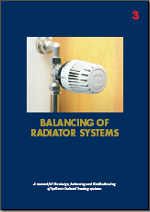Balancing of radiator systems
Poradnik opisujący zasady równoważenia hydraulicznego jedno- i dwururowych układów ogrzewania grzejnikowego.

Tytuł: BALANCING OF RADIATOR SYSTEMS
Autor: Tour &+ Andersson
Język: angielski
Format: Adobe Acrobat Document (.pdf)
Wielkość pliku: 405 KB
Spis treści: - Why balance?
- 1. Balancing of radiator systems 1.1 Overflows cause underflows 1.2 Overflows in distribution
- 2. Radiator valves 2.1 General 2.1.1 When the inlet valve is used only to isolate 2.1.2 When the inlet valve is used to isolate and adjust the flow 2.2 What is a thermostatic valve? 2.3 Thermostatic valves and the supply water temperature 2.4 Is the thermostatic valve a proportional controller? 2.5 Should a plant be hydraulically balanced with all thermostatic valves fully open? 2.6 Accuracy to be obtained on the flow
- 3. Radiators 3.1 Nominal and design conditions 3.2 Selection of a radiator not working in nominal conditions 3.3 Emission of a radiator as a function of the water flow 3.4 Selection of the design water temperature drop 3.5 Existing plants
- 4. Two-pipe distribution 4.1 Balancing of radiators based on a constant Δp 4.1.1 Choosing the design differential pressure 4.1.2 Presetting the thermostatic valve 4.1.3 Non-presettable thermostatic valves 4.1.4 Limitations of choice with the same Δp for all radiators 4.2 Presetting based on calculated Δp 4.3 Constant or variable primary flow 4.3.1 About noise 4.3.2 Constant primary flow 4.3.2.1 A bypass and a secondary pump minimise the Δp on the branch 4.3.2.2 A BPV stabilises the Δp on the branch. 4.3.3 Variable primary flow 4.3.3.1 A plant with balancing valves 4.3.3.2 A Δp controller keeps the Äp constant across a branch
- 5. One-pipe distribution 5.1 General 5.1.1 Advantages 5.1.2 Disadvantages and limitations 5.1.3 Emission from pipes 5.2 One-pipe valves 5.2.1 Constant bypass - variable Kv 5.2.2 Variable bypass - constant Kv 5.2.3 Protection against double circulation 5.3 Proportion of the loop flow in the radiator (Λ coefficient) 5.3.1 50% flow in the radiator (Λ = 0.5) 5.3.2 Choice of another flow in the radiator 5.4 The loop flow 5.4.1 Based on a given ΔT 5.4.2 Based on the largest radiator in the loop 5.4.3 Final choice of the loop flow 5.5 Pressure losses in the loop
Appendices - A. Calculation of radiators in several conditions
- B. Pressure losses in pipes










